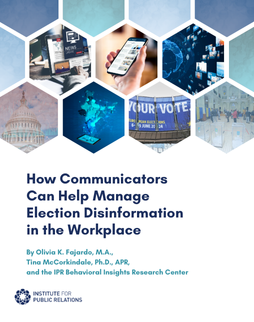This article originally appeared in Bulldog Reporter’s Daily ‘Dog. For more information, visit http://www.bulldogreporter.com/dailydog/.
Since the dawn of public relations, PR people have sought to compute the link between PR and return-on-investment, primarily in the form of a PR-to-sales connection. Now, through new technologies and an advanced form of statistical analysis known as marketing mix modeling, companies in industries ranging from consumer packaged goods to financial services have quantified what we have always believed in our hearts to be true: PR works. Even better, PR consistently outperforms other forms of marketing and at a fraction of the cost.
Unfortunately, after all the effort, sales can be a very fickle marketing measure in a time of commoditization, globalization and a growing distrust of big business. So it seems that just as we’ve overcome marketing’s greatest hurdle, we must contend with another: to go beyond mere sales to create growing, lasting and profitable relationships with our customers.
The PR-to-Sales Connection
Professional communicators have been using PR to deliver value for decades. What’s new is that a handful of leading professionals are scientifically proving how to generate a positive ROI from their PR activities by linking them with sales revenue. This represents a significant change: Rather than relying on a subjective perception of what represents “value,” ROI objectively measures the economic benefits of a public relations activity against its associated costs
and relative to other forms of marketing.
For example, a beverage brand recently measured the impact of PR versus other forms of marketing and its findings are typical: The data showed that $1.00 spent on TV advertising delivered $1.10 in sales. Trade advertising delivered a return of roughly $2.20 for every dollar spent, and PR delivered an outsized $8.00 for every $1.00 invested, the best of any marketing agent tested. Four percent of all incremental sales were attributed to PR. This may not sound like much, but it represents tens of millions of dollars. PR is also the only form of marketing to lift all boats: When news coverage was positive and prominent, every form of marketing was more efficient and more effective.
What’s Wrong with Sales?
Sales can be a capricious measure. And if you have been trained to shop as I have, you’ll recognize this behavior in yourself: Cereal is on sale this week on a three-for-one promotion so you buy six boxes, enough to last until the next sale. But by the time you need more, another brand is on sale: It’s crunchy, it’s sweet and your kids will eat it … so you buy six boxes of that brand.
It’s easy to see how price promotions or “FSCIs” can create a significant sales spike and that’s why so many major brands have become addicted to the practice. But the dirty little secret is that FSCIs actually lose $.25 on the dollar and the sales spikes they create are very short-lived: Price promotions cease to impact sales 24 hours after the offer ends; mass market advertising undergoes a dramatic decline just two weeks following the end of the campaign. PR enjoys an extraordinarily slow decline, but even a six-month decay rate is relatively short-term in the life of a brand. The problem with driving sales for the sake of sales volume is that while brands may be reliable, people are not: They compare, they “price-shop,” and they are disloyal unless given reasons to act differently.
Beyond ROI: Return on Marketing Objectives
Incremental revenues, while alluring, are only one of several critical measures and each of them must contribute to profitability and lasting brand equity. The link between PR and sales has been quantified and having achieved that objective, it’s time now to go beyond ROI. The good news is that no agent is better suited for marketing’s next golden age than public relations.
At Ketchum, we know that PR is indispensable for building reputation and we know how brands with good reputations enjoy many benefits over brands that are lacking: High-reputation brands enjoy premium pricing and are rarely discounted; they benefit from greater loyalty because the brand actually means something to which people can relate; they enjoy the benefit of doubt during difficult times because they have earned the public trust. These brand characteristics, when preciously managed, are enduring: They differentiate, they engage and they build prosperity.
Public relations works particularly well because it achieves a combination of involvement, credibility and compelling story-telling that other marketers envy. And as brands look to invest their marketing dollars on the basis of “what works” rather than “how we’ve always done it,” PR is primed for explosive growth.
The fact that PR delivers the best return-on-the dollar certainly doesn’t hurt-but other forms of marketing can drive short-term sales, too. That’s why PR, which is predicated on building meaningful, lasting relationships at the same time it delivers the best ROI, is uniquely positioned to drive the meaningful interaction that builds the world’s most successful brands.
Get ready: It’s time again to go one step beyond.
Mark Weiner
Senior Vice President and Global Director, Ketchum Global Research Network
Member, Commission on PR Measurement & Evaluation




There is a need to move beyond the fluff and pinttreess of what has been termed marketing for far too long. Measuring what we do, how much we spend, and what it actually contributes to the business is sorely missing.ROI will not die because folks are finally realizing that just marketing with an image and concepts that make you feel good, get praise from a Board of Directors, or owners/investors is not enough. There needs to be a direct connection to business development and growth. ROI measuring will prove to be vital to success. @devilblue82
Nice article. In Kenya PR still a way to go but it is getting recognition with post baby boomers managers – no offence. As O’Neil asks, how best does one measure relationships and more importantly trust in a selling enviroment.
It’s definitely thought-provoking. Many of us in the corporate world are measured and “graded” almost entirely on ROI and sheer numbers – now, looking one step further than basic ROI is a refreshing new challenge. Profit [of course] is important, but lasting relationships and straighforward public trust is everything for enduring brand identity.
Great article! Now we have an empirical evidence to support our longtime argument of the value of good PR practice.
Thanks, Mark and Institute, for sharing.
Gee Ekachai, Associate Professor, Marquette University
Ditto to the remarks by Diana Knott Martinelli. My research and evaluation class will discuss your article this morning. I’m curious to know, how do you measure relationships at Ketchum? Do you use some of the scale items recently developed by PR professors?
Julie O’Neil, Associate Professor at TCU
I think it is a very good article. Undoubtedly PR has a great value.
It’s good to see public relations receiving the attention and credibility it has always deserved, but it also speaks to our society’s obsession with metrics. We only value what we can measure. And so we continue to look for ways to compare ourselves to and differentiate ourselves from advertising and marketing. From my point of view and experience, this means that we still believe we must compete with them on their playing field. We in public relations still act like we have something to prove. When the fact is that we do not act from the same modus operandi as advertising and marketing. As social networking continues its rise as the most trusted source of information, the differences between and among the three disciplines will become crystal clear. Since advertising and marketing are always about the numbers, perhaps it is time for those of us in public relations to be asking–what’s the emotional IQ of advertising and marketing?
Thought-provoking piece, Mark, and timely for one of my PR classes. We’re talking about research and ROI, and this is a good article to share with them. Thanks.
When did you join Ketchum?
Best wishes,
Diana